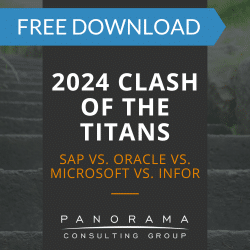Are ERP systems expensive? Average ERP costs vary, but costs definitely add up over time.
Setting realistic expectations for both short and long-term costs is easier said than done. Many organizations underestimate how much money they need to complete their project. This is sometimes due to unrealistic expectations, and other times, it’s related to excessive customization and other unnecessary costs. Often, it’s both.
The key is allocating your budget to vital project activities and closing your wallet when it comes to less vital activities.
Today, we’re sharing how to set an ERP budget and make the best use of it.
Understanding ERP Costs
Before you begin setting a budget for your project, it’s important to understand all the necessary success factors. Too often, companies focus strictly on the cost of the ERP software itself and fail to consider the implementation process, end-user training, and other success factors.
When calculating the total cost of ERP ownership, it isn’t enough to go off the price your vendor gives you. These are usually one-dimensional estimates that fail to include hidden expenses, such as:
- Internal resources
- External consultants
- Hardware and infrastructure upgrades
In addition, there are key processes that you must perform during your project, all of which have their own associated costs. These include but aren’t limited to:
- Resistance management
- Business process management or reengineering
- End-user training
- Post-live implementation support
With so much at stake, why would ERP vendors give companies an inaccurate number? In most cases, they’re simply trying to close a deal. Other times, they actually don’t know what it takes to make an ERP project successful.
Either way, you can’t go off their figures alone. Doing so could mean you have to cut costs at the last minute in a mad dash to salvage your project.
Instead of reactively making those changes, it’s best to control costs throughout your project.
The 2024 ERP Report
88.5% of respondents said they deployed or plan to deploy AI at their organization. Learn about AI adoption and other ERP trends by downloading our latest report.
Setting and Sticking to an ERP Budget
While you don’t want to work with a bare-bones bottom line, you also don’t want to spend lavishly when you don’t need to. The secret to accurately scoping your ERP project is to take a few important factors into account. Let’s take a look at some of the most important.
1. Understand Your Organizational Complexities
Each organization’s ERP budget is unique and depends on the complexity of their operations.
Large, complex organizations might need an expensive, integrated ERP system, while less complex organizations might have a smaller budget as they only need a point solution.
When setting your budget, we recommend working with an independent ERP consultant that can take an unbiased view of your company.
2. Consider People and Processes
When projects get out of scope and run over budget, the problem is usually related to people and processes.
For instance, change resistance might delay your project, leading to higher costs. Similarly, you may overlook process improvement and automate inefficient workflows, creating the need for expensive rework after go live.
3. Compare Costs to Similar Projects
To gain an even better understanding of what your estimated ERP costs might be, we suggest benchmarking your project against other organizations that have undergone a similar implementation. Look at a broad sample to get a more accurate representation of what your expected costs might be.
How to Minimize ERP Costs
Once you get started with your ERP project, there are steps you can take to control costs along the way. Here are a few of our top tips.
1. Avoid Over-Customization
During ERP selection, it’s easy to get starry-eyed over the many bells and whistles available. In addition, you may be considering software customization, all of which might not be necessary.
To keep costs low, consider only implementing the basic functionality that you need right now or in the near future. This way, you can use the system as-is for a while, and then determine if you need more advanced functionality down the road.
2. Compare Vendor Costs
Rather than selecting the first vendor you come across, it pays to do your due diligence. A software contract negotiation consulting team to help you compare contacts and terms, while negotiating on your behalf for the best price and the most comprehensive (and realistic) statement of work.
3. Prioritize OCM
Sure, you could just implement a solution and force employees to adopt it, but that’s unlikely to work out the way you expected.
Instead, we recommend focusing on organizational change management. This is a short-term cost that can reduce your long-term costs.
For example, when you make change management a key part of your ERP project, you lower your risk of employee resistance.
In turn, when your workforce is on board with the change, the less time and money you’ll spend working through roadblocks while your system sits unused.
4. Maximize ERP Consultant Expertise
To get the most benefit from your ERP implementation consultant, it’s important to use the consultant’s time wisely.
This means focusing on pre-implementation planning before engaging consultants. This allows you to make certain business decisions in advance, so you’re not deliberating about workflow configurations and whatnot while the clock is ticking.
Another tip to keep in mind is that you should rely on consultants for not only technical expertise but also business expertise. In this way, they can assist you with activities like business process reengineering and organizational change management.
Can You Afford an ERP Implementation?
The answer is likely yes, as long as you set realistic expectations and maintain control of your ERP budget.
The Panorama team can help you evaluate your options and make decisions that make financial sense. Contact us below for a free ERP consultation.














